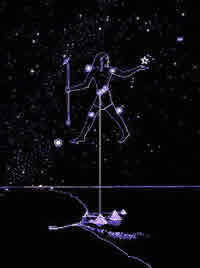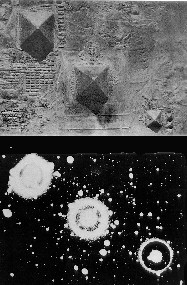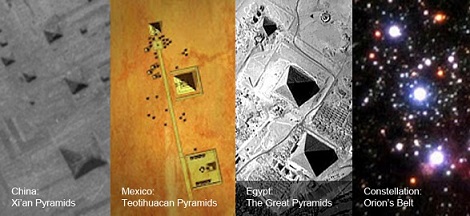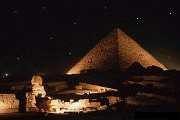Official historiography assigns the pyramids of Giza, Egypt, an approximate median age of about 4,500 years (Great Pyramid). The three pyramids on the plateau of Giza are attributed to the pharaohs Chufu (Cheops), Chafra (Chefren) and Menkaure (Mykerinos). Both are incorrect.
The pyramids of Giza originate from the Atlantis period. In their overall arrangement they represent an embassy complex which documents the connection of the then third generation of earthly people with the confederation of the Orion constellation. The entire complex was more complex in its origin than is visible at present. The overall structure of the complex was, by its architectural nature, an earthly image of the constellation of Orion.
The entire complex was more complex in its origin than is visible at present. The overall structure of the complex was, by its architectural nature, an earthly image of the constellation of Orion.
The Belgian historian, book author and expert Egyptologist (untitled) R. Bauval, together with colleagues, deciphered the pyramid complex on the high plateau. His British colleague Graham Hancock, in turn, published findings obtained using scientific methods, which in particular took into account the role of sphinxes on the plateau. Both dated the "image" of the pyramid in the cosmos transferred to the centre of the constellation of Orion, especially the three belt stars Al-Nilam, Al-Nitak and Mintaka, the home worlds of Aton. The three pyramids correspond in their size in analogy to the relative brightness of the belt stars. Hancock continued to bring together other scientists, including several geologists, to further study the sphinxes. It turned out that the waters of the Flood now make the sphinxes look as they currently appear to us.
The shafts leading from the King's Chamber and the Queen's Chamber in the Great Pyramid at Giza do not simply lead to the northern and southern skies as classical Egyptology would have us believe, but are much more precisely aligned. They date from around 10,500 BC  and are directed towards the stars (images): Orion, the belt stars or their centres, and the Sirius system on one side, and on the opposite side towards the then "North Pole", the North Star alpha draconis and beta ursae minor in the same direction.
and are directed towards the stars (images): Orion, the belt stars or their centres, and the Sirius system on one side, and on the opposite side towards the then "North Pole", the North Star alpha draconis and beta ursae minor in the same direction.
The constellation of Orion in its present grouping, which is based on mythology, is not a classification of modern times. In the Sumerian Empire, for example, this arrangement was represented by the mythological image of Gilgamensch (chald.: SIPA.ZI.AN.NA) (the Sumerian rulers - EN.LIL, ANU, ISHTAR and others - were aliens from the Sirius system). Together with sphinxes, which originally probably wore a lion's head, since its entire archaeo-astronomical orientation towards the constellation of the lion probably points to 10.500 B.C., the complex depicts a clearly different time than classical Egyptology, which wants us to believe that the largest pyramid (erroneously called "Pyramid of Khufu") dates back to 2.450 B.C.
Another aspect of the Giza puzzle is probably the depiction of links in the chain of the Fibonacci sequence, which is reflected everywhere on the pyramid complex. The same mathematics that is found in the Pyramids of the Sun and Moon in Teotihuacan, Mexico and the Xi'an Pyramids in China.
In this Aquarian Age, it is time to reassess the knowledge of the past. Great knowledge about our Earth's past, which has always been preserved by the few at all times, will become available to the entire Earthly public.
Earthly humanity will regain its place in the international community of the universes in the foreseeable future.



![]()
" "Oh, Egypt! Egypt! "Of your knowledge only fables will remain, incredible to later generations."
Lucius Apuleius, Roman philosopher, 2nd century AD.
 Giza
Giza 
